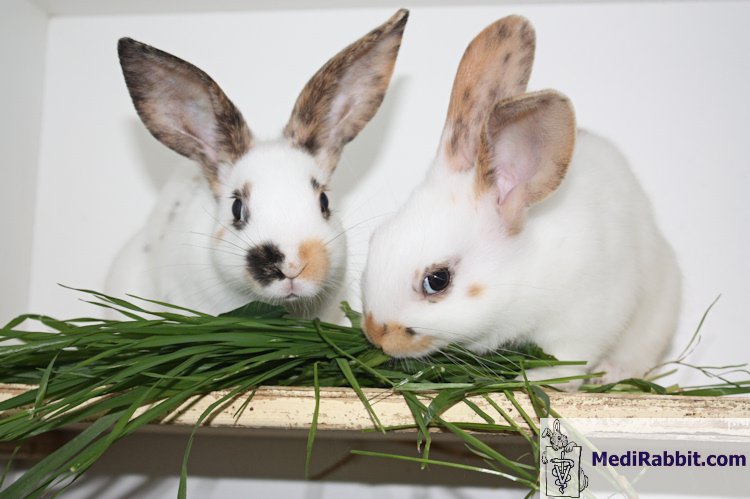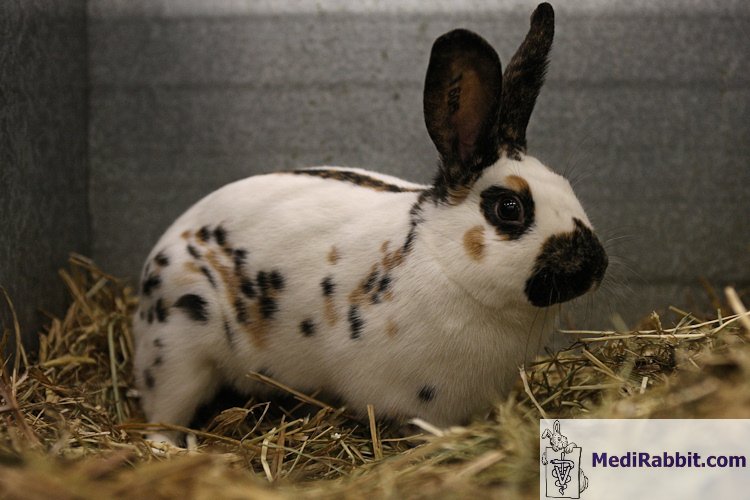Megacolon in
spotted/checkered rabbits
Esther van Praag Ph.D.
MediRabbit.com is funded solely by the
generosity of donors.
Every donation, no matter what
the size, is appreciated and will aid in the continuing research of medical care
and health of rabbits.
Thank you
|
Warning: this file contains pictures that may
be distressing for people
Hello,
I am Zippy
a small tricolor Charlie rabbit, over 2 years old. I was born with a congenital
disorder that affects roughly 25% of all spotted and checkered rabbits with a
butterfly surrounding the nasal region: megacolon.
We, Charlie’s, are bicolored or
tricolored spotted straight eared or lop rabbits, characterized by fur is
more white over our body than our litter brothers and sisters. Our nasal
butterfly is reduced and stops in the middle of our upper lip already, which
led to the surname “Charlie”, a reminder of the moustache of Charlie Chaplin.
Our eyes are surrounded by a ring of colored fur, our nasal region has typically a partial butterfly or spots, our ears are usually colored, a colored spot is found on our cheek and we have a finer and/or partial dorsal line. Spots on the hip region are reduced or absent.The spotted fur is under control
of the 'En' gene, which is dominant on the 'en' gene, responsible for colored
fur throughout the body. An 'enen' individual will have colored fur all over
its body, while an 'Enen' individual will be spotted/checkered, and an 'EnEn'
rabbit will be a Charlie with a very white fur. Offspring of two spotted
rabbits (e.g., the Swiss Petit Papillon Tricolor rabbit) that each
necessarily have the 'En' gene, will thus be composed of newborns possessing:
·
Heterozygous 'Enen' offspring with a spotted coat,
·
Homozygotes 'enen' offspring with a harlequin coat,
·
Homozygotes 'EnEn' offspring with the
characteristic white fur characteristics and few colored regions only.
Charlie
spotted rabbits suffer from the megacolon syndrome
The
deleterious effects of the 'En' gene manifest themselves at several levels in
homozygous 'EnEn' individuals. Many newborns die at weaning or shortly
thereafter. Those that survive often develop chronic megacolon, a syndrome
that worsens with age. This condition is caused by an abnormal dilation of
the colon and by the absence of neuroganglionic cells (aganglionosis)
regulating the muscular contractions of the digestive system, which allow its
content to progress towards the anus. The activity of the intestine as well
as the cecum is affected.
The small intestine is shorter in
megacolon rabbits, compared to normal rabbits. The pH of the intestinal
content at the initial portion of the small intestine (duodenum) is also
lower than that observed in normal rabbits.
Absorption of sodium (Na+)
through the wall of the cecum is much reduced. As a result, this organ has a
reduced content of dry matter derived from the ingested food. Abnormal
liquefaction of the intestinal content has also been observed in the first
half of the colon (proximal colon).
The heart and adrenal glands of
megacolon rabbits are larger than those of healthy rabbits. It is possible
that the increase in the size of these organs is associated with the
metabolic megacolon disorder.
Effects of
megacolon on health and fecal production
Abnormalities
of the intestine and the cecum result in a distension of the abdomen.
Megacolon rabbits often have the appearance of having a pot belly stomach.
These changes lead to intestinal food malabsorption and, consequently,
nutritional deficiencies. These rabbits must receive a variety of food rich
in fiber: good quality pellets containing minerals and vitamins, fresh hay
and, if tolerated, a variety of fresh vegetables and aromatic herbs. In some
megacolon rabbits, the administration of vitamin C or multi-vitamin supplements
has allowed them to gain vitality and produce more normal looking and drier
hard droppings.
Fecal production is also
affected. The hard droppings are large, oval, and rich in water, like a
sponge. It is impossible to detect the presence of fibers when fresh. The
latter only appear once the droppings have dried out, which may take a few
days.
Mucus is often present, which is
indicative of a disorder or irritation in the intestine.
The loss of fluid mucus via the
anus colors the hair of the perineal region. This characteristic helps
confirm the diagnosis of megacolon in spotted rabbits.
Some
anecdotic studies mention that megacolon rabbit may never produce cecal
droppings. Zippy did, however, bend down towards his anus several times a
day, then took the characteristic position of any rabbit ingesting his
“trophy”.
A megacolon crisis is caused by
the passage of a particularly large hard dropping and is accompanied by
abrupt and violent abdominal spasms. Droppings collected at the end of such a
crisis often present an outgrowth. Thir progression through the intestine was
accompanied by severe pain. Zippy did often moan, in spite of analgesic
medication, and he would knock strongly onto his abdomen with his nose during
these episodes.
Help a Charlie
rabbit during an acute crisis ?
More and more spotted
straight-eared or lopped rabbits become pet rabbits nowadays. It is,
therefore, important to understand the causes of intestinal crises and be
able to treat them. To date, there is no consensus between veterinarians and
experts.
Crises are episodic,
characterized by sudden outbreaks and calm periods. Dehydration, lack of
fiber, nutrient deficiencies, or stress (unusual noise, abrupt weather
changes) may trigger them. During a crisis, Zippy had been administered a
painkiller (Metacam) and received 2 ml of virgin olive oil orally. This oil
has stimulating properties on the intestinal peristaltic movement. It acts
softly, without intestinal cramps (there is a risk of rupture of the caecum
during these crises) in contrast to chemical stimulants of the peristaltic
movement (e.g. metoclopramide, cisapride). Zippy was kept hydrated orally
with a syringe. Hay and fresh or dried greens possessing carminative or
antispasmodic properties such as celery branches, coriander, fennel, thyme,
lemon balm, or raspberry leaves were given on a daily basis, at will. If he
tolerates it, his abdomen is gently massaged and he was encouraged to
exercice. The longest crisis up to the age of 2 years lasted 9 hours.
Luckily, Zippy came out well every time. The frequency of intestinal crises
decreased after Zippy was given sunflower seeds daily.
Zippy died at the young age of 4
years and some weeks after struggling with renal failure during the last
weeks of his life.
MediRabbit Acknowledgement
Many thanks to Michel Gruaz
(Switzerland) for sharing his knowledge about megacolon in rabbits and for
precious Zippy.
|
e-mail: info@medirabbit.com













